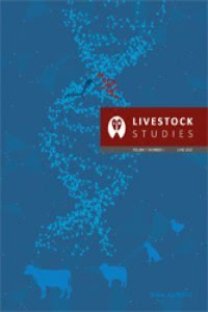The Effect of Zinc Supplementation on Plasma Melatonin and Kisspeptin Levels in Rams
The study that researched the effect of zinc added to the rations of rams on kisspeptin and melatonin levels was conducted on 2 years old 12 Kivircik crossbreed rams (6 control, 6 experimental) for 1 year. In addition to the ad libitum dry alfalfa straw, it was given mixed feed (barley, salt and vitamin-mineral mixture as standard) supplemented with 25 mg/kg/ DM ZnO, for the control group and 125 mg/kg/ DM ZnO for experimental group per day. During the study, blood samples were taken once a month and kisspeptin and melatonin levels were measured with ELISA in plasmas obtained from blood samples. Melatonin levels were found to be between 62.8-164.5 ng/L in experimental group and 22.1-105.9 ng/L in control group. Kisspeptin levels were determined to be between 209.8-514.2 ng/L in experimental group and 92.6-356.6 ng/L in control group. Zinc supplementations showed numerical increases in kisspeptin and melatonin levels but because of the individual variations, no statistical significance was found (P > 0.05).
Keywords:
Kisspeptin, Melatonin Zinc, Ram,
___
- Ancel, C., Bentsen, A.H., Sebert, M.E., Tena-Sempere, M., Mikkelsen, J.D., & Simonneaux, V. (2012). Stimulatory effect of RFRP-3 on the gonadotrophic axis in the male Syrian hamster: The exception proves the rule. Endocrinology, 153: 1352-1363. https://doi.org/10.1210/en. 2011-1622
- Alvarado, M.V., Carrillo, M., & Felip, A. (2015). Melatonin-induced changes in kiss/gnrh gene expression patterns in the brain of male sea bass during spermatogenesis. Comparative Biochemistry Physiology, 185, 69-79. https://doi.org/10.101 6/j. cbpa.2015.03.010
- Baltacı, A.K., Moğulkoç, R., Bediz, C.S., Kul, A., & Ugur A. (2003). Pinealectomy and zinc deficiency have opposite effects on thyroid hormones in rats. Endocrine Research, 29(4), 473-81. https:// doi.org/10.1081/erc-120026953
- Baltacı, A.K., Mogulkoc R. (2017). Leptin, NPY, melatonin and zinc levels in experimental hypothyroidism and hyperthyroidism: The relation to zinc. Biochemical Genetics, 55(3), 223-233. https://doi.org/10.1007 /s10528-017 -9791-z
- Bediz, C.S., Baltaci, A.K., & Moğulkoç, R. (2003). Both zinc deficiency and supplementation affect plasma melatonin levels in rats. Acta Physiologica Hungarica, 90(4), 335-339. https://doi.org/10. 1556/APhysiol.90.2003.4.7
- Buchanan, K.L., Yellon, S.M. (1991). Delayed puberty in the male djungarian hamster: Effect of short photoperiod melatonin treatment on the GnRH neuronal system. Neuroendocrinology, 54(2), 96-102. https://doi.org/10.1159/00012 58
- Carnevalli, O., Gioacchini, G., Maradonna, F., Olivotto, I., & Migliarini, B. (2011). Melatonin induces follicle maturation in Danio rerio. Plos one 6, e19978. https://doi.org/ 10.1371/journal.pone.0019978
- Clarke, I.J., Qi, Y., Puspita, I., & Smith, J,T. (2009a). Evidence that RF-amid related peptides are inhibitors of reproduction in mammals. Frontiers in Neuroendocrinology, 30(3), 371-78. https://doi.org/10.1016/j.yfrne. 2009.04. 001.
- Clarke, I.J., Smith, J.T., Caraty, A., Goodman, R.L., & Lehman M.N. (2009b). Kisspeptin and seasonality in sheep. Peptides, 30(1), 154-163. https://doi.org/10.1016/j.peptides.2008.08.022
- Goodman, R.L., Jansen, H.T., Billings, H.J., Coolen, L.M., & Lehman, M.N. (2010). Neural systems mediating seasonal breeding in the ewe. Journal of Neuroendocrinology, 22(7), 674- 681. https://doi. org/10.1111/j.1365-2826. 2010.02014.x
- Hanlein, G.F.W., Anke, M. (2011). Mineral and trace element research in goats- A Review. Small Ruminant Research, 95, 2-19. https://doi. org/10.1016/j.smallrumres.2010.11.00
- Irwig, M.S., Fraley, G.S., Smith, J.T., Acohido, B.V, Popa, S.M, Cunningham, M.J., Gottsch, M.L., Clifton, D.K., & Steiner, R.A. (2004). Kisspeptin activation of gonadotropin releasing hormone neurons and regulation of Kiss1 mRNA in the male rat. Neuroendocrinology, 80(4): 264-272. https://doi. org/10.1159/000083140.
- Lee, J.H., Miele, M.E., Hicks, D.J., Phillips, K.K., Trent, J.M., Weissman, B.E., & Welch, D.R. (1996). Kiss1, a novel human malignant melanoma metastasis-suppressor gene. Journal of the National Cancer Institute, 88,1731-37. https://doi.org/10.1093/ jnci/88.23.1731
- Ohtaki, T., Shintani, Y., Honda, S., Matsumoto, H., Hori, A., Kanehashi, K., Terao, Y., Kumano, S., Takatsu, Y., Masuda, Y., Ishibashi, Y., Watanabe, T., Asada, M., Yamada, T., Suenaga, M., Kitada, C., Usuki, S., Kurokawa, T., Onda, H., Nishimura, O., & Fujino, M. 2001. Metastasis suppressor gene Kiss1 encodes peptide ligand of a G-protein-coupled receptor. Nature, 411(6837), 613-617. https://doi.org/10. 1038/35079135
- Öztürk, G., Akbulut, K.G., & Afrasyap L. (2008). Age-related changes in tissue and plasma zinc levels: modulation by exogenously administered melatonin. Experimental Aging Research, 34(4), 453-462. https://doi.org/10.1080/0361 07308022 71922
- Revel, F.G., Saboureau, M., Masson-Pévet, M., Pévet, P., & Mikkelsen, J.D. (2006). Kisspeptin mediates the photoperiodic control of reproduction in hamsters. Current Biology, 16, 1730-1735. https://doi.org/10.1016/j.cub.2006.07.025
- Quershi, I.Z., Abbas, Q. (2013). Modulation of testicular and whole blood trace element concentrations in conjunction with testosterone release following kisspeptin administration in male rabbits (Oryctolagus cuniculus). Biological Trace Element Research, 154, 210-16. https://doi.org/10.1007/s 12011-013-9720-x
- Song, Y.M., Chen, M.D. (2009). Effects of melatonin administration on plasma leptin concentration and adipose tissue leptin secretion in mice. Acta Biologica Hungarica, 60, 399-407. https://doi. org/10.1556/ABiol.60.2009.4.6
- Viguie, C., Caraty, A., Locatelli, A., & Malpaux, B. (1995). Regulation of luteinizing hormone-releasing hormone (LHRH) secretion by melatonin in theewe. II. Changes in N-methyl-D,L- aspartic acid-induced LHRH release during the stimulation of luteinizing hormone secretion by melatonin. Biology of Reproduction, 52(5), 1156-1161. https://doi.org/ 10.1095/biolreprod52.5.1156
- Wagner, G.C., Johnston, J.D., Clarke, I.J., Lincoln, G.A., & Hazlerigg, D.G. (2008). Redefining the limits of day length responsiveness in a seasonal mammal. Endocrinology, 149, 32-39. https://doi.org/10. 1210/en.2007-0658
- Yayın Aralığı: 2
- Başlangıç: 1959
- Yayıncı: Sezer ÖZ
